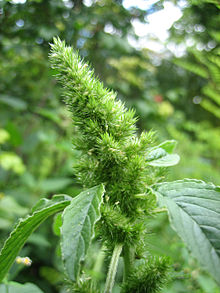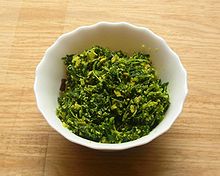- Amaranthus retroflexus
-
Amaranthus retroflexus 
Scientific classification Kingdom: Plantae (unranked): Angiosperms (unranked): Eudicots (unranked): Core eudicots Order: Caryophyllales Family: Amaranthaceae Genus: Amaranthus Species: A. retroflexus Binomial name Amaranthus retroflexus
L.Amaranthus retroflexus is a species of flowering plant in the Amaranthaceae family with several common names, including Red-root Amaranth, Redroot Pigweed, Red Rooted Pigweed, Common Amaranth, and common tumble weed.[1]
Contents
Description
True to its name, it forms a tumbleweed.[1] It is native to the tropical Americas but it is widespread as an introduced species on most continents in a great number of habitats. This is an erect annual herb reaching a maximum height near 3 meters. The leaves are nearly 15 centimeters long on large individuals, the ones higher on the stem having a lance shape and those lower on the plant diamond or oval in shape. The plant is monoecious, with individuals bearing both male and female flowers. The inflorescence is a large, dense cluster of flowers interspersed with spiny green bracts. The fruit is a capsule less than 2 millimeters long with a "lid" which opens to reveal a tiny black seed.
Culinary use
Southern Kerala-style traditional Thoran made with Cheera (Amaranthus retroflexus) leaves.
This plant is eaten as a vegetable in different places of the world. No species of genus Amaranthus are known to be poisonous[2], but the leaves contain oxalic acid and may contain nitrates if grown in nitrate-rich soils, so the water should be discarded after boiling.
Amaranthus retroflexus was used for a multitude of food and medicinal purposes by many Native American groups.[3]
Amaranthus retroflexus is used in the Indian state of Kerala to prepare a popular dish known as thoran by combining the finely cut leaves with grated coconut, chilies, garlic, turmeric and other ingredients.
Use as fodder
When fed to cattle and pigs in large amounts over several days, this plant might be harmful by causing nephrotoxicity.[4]
External links
References
- ^ a b Louis Hermann Pammel (1903). Some Weeds of Iowa. Experiment Station, Iowa State College of Agriculture and the Mechanic Arts. http://books.google.com/books?id=croUAAAAYAAJ. page 470
- ^ Plants for a future
- ^ Ethnobotany
- ^ FEIS Ecology
Categories:- Amaranthus
- Flora of Michigan
- Flora of North Dakota
- Flora of Alabama
- Ruderal species
Wikimedia Foundation. 2010.

